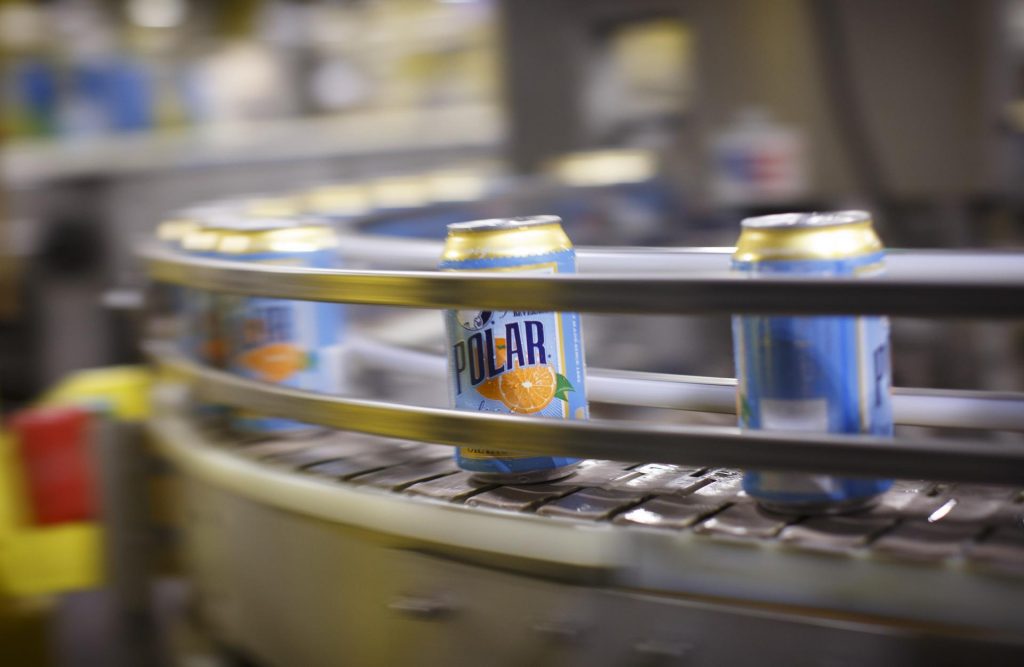WORCESTER — Ralph Crowley doesn’t have any idea what a unicorn kiss is, but he’s hoping it tastes something like success.
As the chief executive of Polar Beverages, the 134-year-old bottling company in Worcester, he’s spent the past decade watching as consumer tastes have shifted from syrupy sodas to lighter, calorie-free carbonated drinks. Americans’ newfound obsession with seltzer has led to unprecedented growth for Polar, five generations after it was founded by the Crowley family.
It’s also led to something stranger: cachet. When Polar unveils new flavors several times a year, its devotees swarm grocery stores and post pictures of themselves cradling armfuls of bottles using the hashtag #blessed.
A limited edition bottling of a mystery flavored “Unicorn Kisses” this spring sparked a social media frenzy. One-liter bottles of the conconction are now listed on eBay for as much as $100.
All that buzz is a bit bewildering for Crowley, 65, who jokes that Polar is an overnight success, more than a century in the making.
But as he looks over sprawling factory complex from a conference room atop the company headquarters, he also worries. Bubbles have been good to him, but sometimes they burst.
“We’ve never grown so fast, we’ve never been in a better position, and I’ve never been so scared,” he said.
Ralph Crowley is the president and CEO of Polar Seltzer, seen here in front of a vintage Polar Seltzer sign in the company’s Museum Room.
Polar had $450 million in annual sales last year, up from $275 million a decade earlier,and employs 1,700 people at plants in Worcester, upstate New York, and Georgia. But as it seeks to push farther down the Eastern Seaboard and out to the West Coast, it faces a increasingly crowded market. In the past five years, beverage giant Coca-Cola Co. released six new seltzers, and Pepsi Inc. has launched three, and the rise of niche brands such as Florida-based LaCroix has turned heads in the industry.
Much of Polar’s success hinges on whether the company can find a place for its puckish message in an increasingly crowded beverage case.
“There’s a lot to be said for being the established brand that people know and love,” said Gary Hemphill, managing director of research at Beverage Marketing Corporation. “But they have to stay on their toes.”
Long a mixer of choice for the greatest generation, seltzer water has found a new audience amid the soda averse, with 168,000 million gallons now consumed annually — 5o,000 more than five years ago — according to the industry analysts at Beverage Marketing Corp. The Nielsen research group tracked a 21.6 percent spike in seltzer purchases in 2015 alone, the first year the category saw over $1 billion in sales.
Polar’s origins began in Worcester back in 1882. After ditching the whiskey business during Prohibition, the Crowleys bet on bubbles, creating a concoction for their Orange Dry in 1933 that remains a company stalwart. A series of maneuvers and acquisitions have enabled Polar’s continued success, particularly the complex mix of bottling rights they’ve brokered with other beverage groups. Even as a regional beverage brand, Polar has quietly grown to become the country’s largest independent soft-drink bottler.
Its factory blends all Snapple, 7UP, and Sunkist drinks in the Northeast and produces private label seltzer for grocery chains like Market Basket and Piggly Wiggly. Nestle is the company’s biggest competition, but the Swiss behemoth is also Polar’s biggest customer, as the company bottles all of its Nestea and Poland Spring drinks in the Northeast.
“We tried to create a business that was complex enough that Coke or Pepsi couldn’t just walk up and knock us over,” Crowley said.
Polar’s folksy history could help its position it in the marketplace as it grows, said Darren Seifer, a food and beverage industry analyst with the NPD Group. Just as craft beer is gaining in its share of alcohol sales, in part based on personal narratives behind each small brewery, he said that new drinkers might tend to look for the origin story behind their seltzer.
“There is this mentality amongst the younger generations, there is a preference for more mom and pop or more local type establishments,” Seifer said. “If they can act as the small nimble player in the market, they might be able to garner some sympathy from some of these younger consumers out there.”
Of course, there are also smaller, and perhaps more nimble players to contend with like Spindrift, the Waltham-based maker of all-natural seltzers and sodas, which are now distributed nationally at Target and Trader Joe’s. The six-year-old company’s founder, Bill Creelman, said while he wouldn’t speak directly about Polar’s “all-natural flavors,” he did say how he hopes Spindrift’s seltzers can stand out.
“We’re America’s first and only sparkling water made with real fruit,” he said, putting a not-so-subtle emphasis on the word ‘real.’ “I can point to the tree that our blackberries came from.”
But Crowley, too, hopes Polar can stay ahead by winning the flavor game.
“Humbly, I think we’re the best at making flavors,” he said. “And I can tell you, humbly, its not my generation that’s doing it.” The company’s next chapter, he says, will be written by the younger Crowleys.
Thousands of of cans are directed along a conveyor belt at the Polar Seltzer production facility in Worcester.
Polar’s national play hinges on several things: the diaspora of New England-educated college students who become infatuated with the brand and then relocate elsewhere after graduation, and on the company’s recent capacity to regularly introduce new flavors. The company employs an in-house mixologist to develop its flavors and now releases a series of five limited edition varietals twice a year — this summer’s selection included watermelon margarita and tangerine limeade — along with small batch special flavors like Irish coffee for St. Patrick’s Day.
Crowley is thrilled (and somewhat amused) seeing millennials guzzling cases of seltzer, while matching their favorite flavors to the color of their nails, but he’s also intent on getting his bottles into the hands of young moms, who increasingly see the drink as a calorie-free treat they feel comfortable sharing with kids.
The marketing team is constantly monitoring food blogs and cocktail culture to stay on top of flavor trends and says it oftens finds inspiration from its customers.
This approach can work, said Seifer, the beverage analyst, but only to a point. “If you come up with line extensions and new flavors, it’s important for the flavor to be believable,” he notes.
Polar’s national expansion is already well underway, with deals recently inked to get into southern supermarket giants Harris Teeter and Publix and is in talks with the Albertsons chain in Seattle. And Crowley hopes his good karma as a bottling partner to other brands will offer inroads into other markets on the West Coast.
“As long as we can keep being the fun one and the innovative one, we’ll be just fine,” he said.
“What’s the worst that could happen?” he adds. “A mess in aisle seven?”
Nanos, Janelle. (2016, July 25). A sparkling new era for time-tested Polar. The Boston Globe.
Retrieved from https://www.bostonglobe.com/business/2016/07/25/bubbles-their-blood/D7xovVZNM9QXz5JPgn0tgJ/story.html

